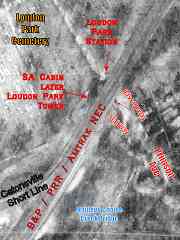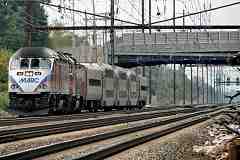|
Loudon Park Station was one of three B&P structures on the northwest side of
the main line tracks between the Claremont Branch and Catonsville Short Line
(CSL), a Class III railroad that served Catonsville, Maryland. Though the
CSL ceased operation during 1972, enough artifacts are found to warrant its
own tour pages.
The largest structure was SA Cabin, later named Loudon Park Tower, southwest of
a passageway under the tracks that connected Primson Avenue with the cemetery.
Loudon Park Station, little more than a waiting shack, sat north of the
passageway.
Polk's Baltimore Maryland City business directory of 1906 reports,
"LOUDON PARK STATION (B&P RR), SE side of Loudon Park Cemetery." The B&P
name hung on after it was incorporated into the Philadelphia, Wilmington &
Baltimore Railroad during 1902. Remember, these were little more than names
since both companies were under control of PRR.
|























